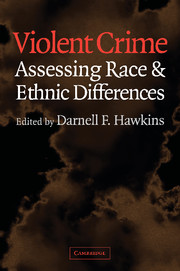Book contents
- Frontmatter
- Contents
- Contributors
- Foreword
- Editor's Introduction
- Violent Crime
- Part I Homicide Studies
- 1 Homicide Risk and Level of Victimization in Two Concentrated Poverty Enclaves: A Black/Hispanic Comparison
- 2 Moving Beyond Black and White Violence: African American, Haitian, and Latino Homicides in Miami
- 3 Homicide in Los Angeles County: A Study of Latino Victimization
- 4 Economic Correlates of Racial and Ethnic Disparity in Homicide: Houston, 1945–1994
- 5 The Race/Ethnicity and Poverty Nexus of Violent Crime: Reconciling Differences in Chicago's Community Area Homicide Rates
- Part II Other Contexts, Settings, and Forms of Violence
- Part III Explaining Racial and Ethnic Differences
- References
- Index
3 - Homicide in Los Angeles County: A Study of Latino Victimization
Published online by Cambridge University Press: 22 August 2009
- Frontmatter
- Contents
- Contributors
- Foreword
- Editor's Introduction
- Violent Crime
- Part I Homicide Studies
- 1 Homicide Risk and Level of Victimization in Two Concentrated Poverty Enclaves: A Black/Hispanic Comparison
- 2 Moving Beyond Black and White Violence: African American, Haitian, and Latino Homicides in Miami
- 3 Homicide in Los Angeles County: A Study of Latino Victimization
- 4 Economic Correlates of Racial and Ethnic Disparity in Homicide: Houston, 1945–1994
- 5 The Race/Ethnicity and Poverty Nexus of Violent Crime: Reconciling Differences in Chicago's Community Area Homicide Rates
- Part II Other Contexts, Settings, and Forms of Violence
- Part III Explaining Racial and Ethnic Differences
- References
- Index
Summary
Most people are aware of two facts about homicide and violence. First, poverty and economic disadvantage are related to violence and, second, the majority of minorities are found in urban areas of poverty, economic disadvantage, and high rates of violence. These two views are cobbled together in the view that poverty and economic disadvantage affect all minorities in the same way to produce violent behavior.
In part, this perspective has the consequence of believing that the large amount of research on African-American violence can be readily generalized to other groups. Thus, as Martinez (1996; 1997a; 1997b; 1999) notes, there is little research on Latino crime and few studies comparing Latino violence to violence among whites and other minorities.
It is becoming increasingly apparent that Latinos cannot be indiscriminately grouped with other minorities in studying crime. In the last few decades, a social construction of Latino gangs and Latino violence has appeared (Spector and Kitsuse, 1987; Klein, Maxson, and Miller, 1995). The view of Latinos interms of a “social problem” of gangs and violence has probably been spurred on by the increase of immigration in Florida, Texas, and California. Finally, the Uniform Crime Reporting Program and National Center for Health Statistics began in the 1980s to collect information on Latino homicides and other crimes. The availability of this data has been an important stimulus to research exploring differences between Latino crime and crimes of other minorities.
- Type
- Chapter
- Information
- Violent CrimeAssessing Race and Ethnic Differences, pp. 44 - 66Publisher: Cambridge University PressPrint publication year: 2003
- 4
- Cited by



